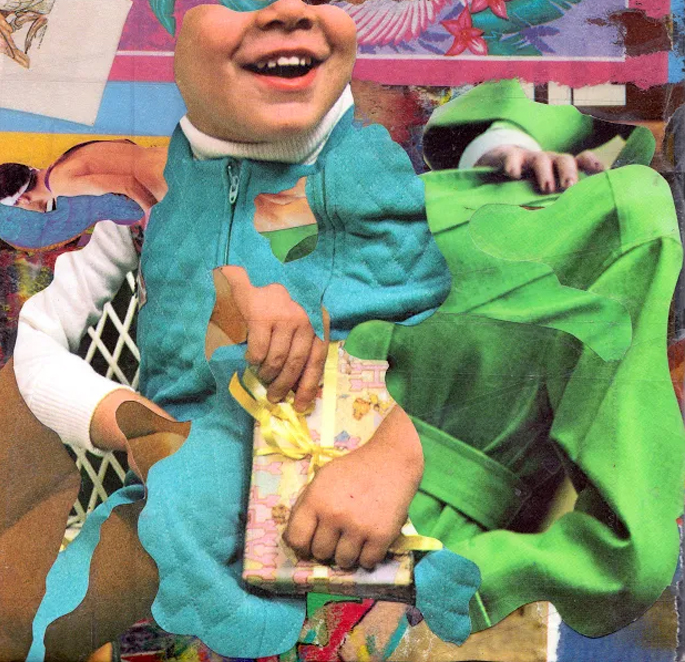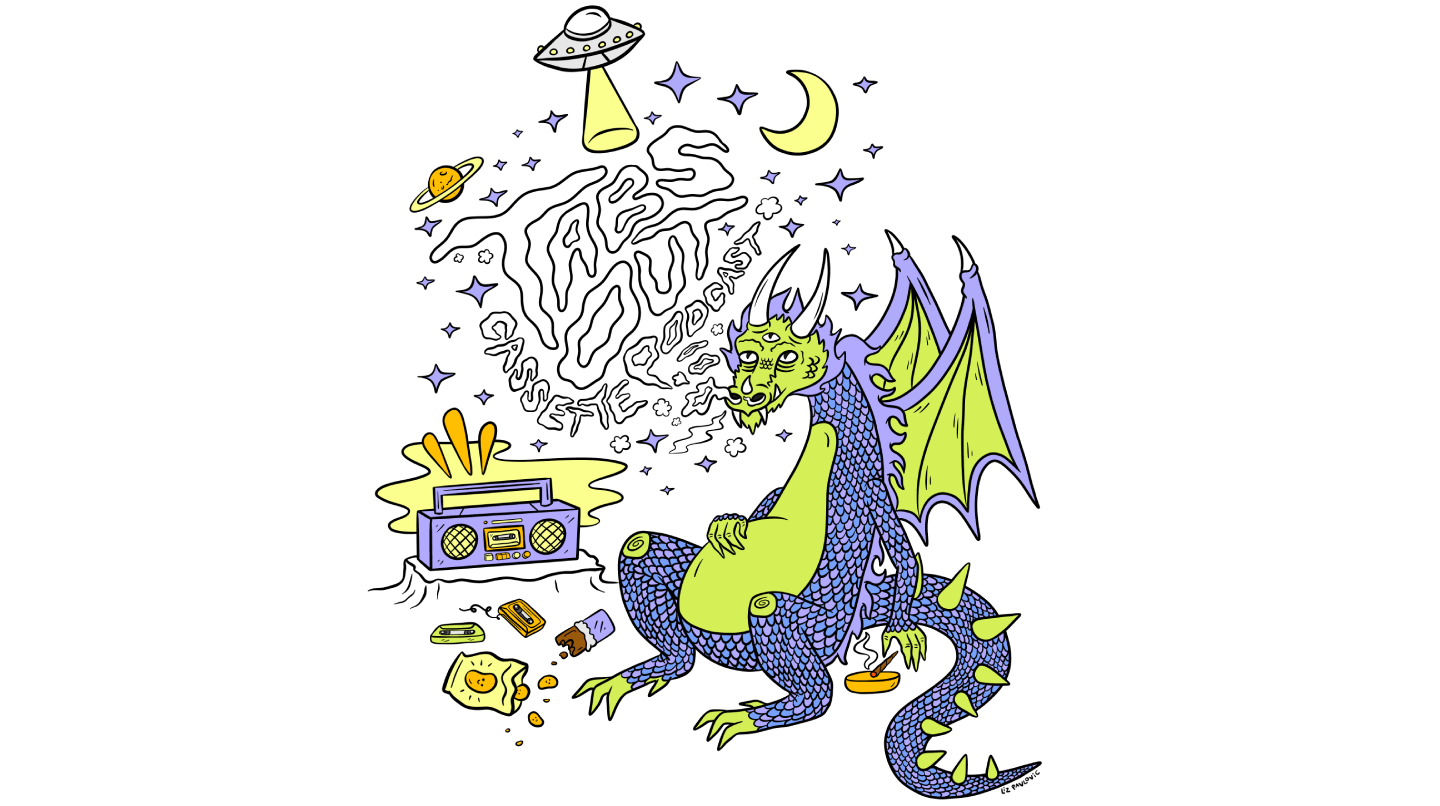Interview – id m theft able
4.19.18 by Jacob DeRaadt
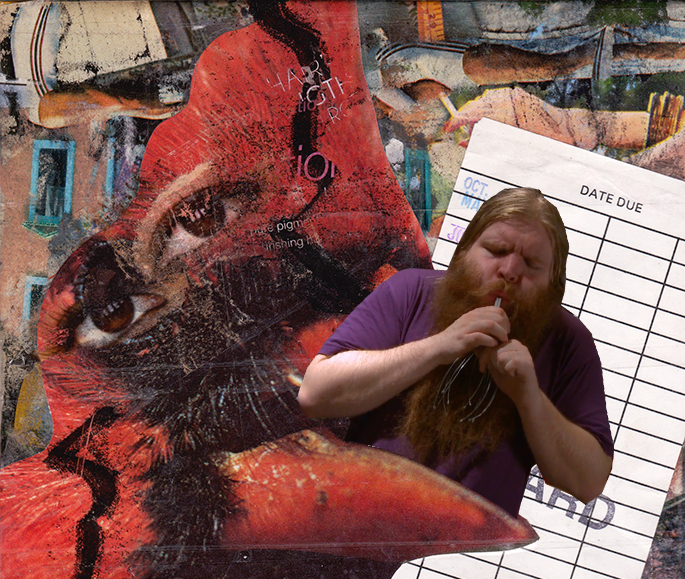
Skott (aka: id m theft able) is one of those people that I knew through trading tapes of thrift-store cut-up in the mail for years before seeing him perform live with an amplified table of various re-imagined objects, prepared digital cut up, radio, and THOSE VOCALS. Since moving to Portland, Maine, I’ve had the pleasure of a lot of conversations with Skott about our shared love of experimental music and hair metal, growing up in small towns, and seeking out sounds on your own as a teenager. I wanted to ask Skott questions about elements that link up his total art worlds which seem fairly evenly divided between sound and visual collage. Here’s some of them that took place in summer/fall of 2017 about his visual and sound practice, the DOES series of shows he curates, side project 3D Jet Scooter,and his long-standing label MANGDISC.
You said something in an earlier interview about comparing your voice to a saxophone. Do you listen to much horn stuff?
Sure, I don’t focus on it particularly, but I do like free-improv and free jazz.
How does comedy fit into your perspective of your sound work?
I never set out to be funny, but I know that sometimes if I follow through with particular impulses I have people are probably going to laugh. I had a dream once that I ripped a soccer ball apart on stage, so I decided to try it in real life. So I got a soccer ball and tore the panels off one by one, the panels had strings attached between them and the ball and as I pulled them off I made a crude sort of lute. I plucked the improvised strings and sang in a falsetto. Of course people laughed, and though I wasn’t trying to be funny, I’m glad they were engaged. It was interesting to me so I did it, how people react to it after I do it is out of my hands. No response is invalid. That said, I like and am influenced by comedy.
When I was younger, I did worry about doing things that would undermine the “seriousness” of my intentions. This now seems laughably stupid and pointless to me. I did away with any pretense of being taken seriously/not seriously over time, and it’s quite liberating to simply have faith in my impulses and intentions and not worry about any of that anymore. Serious/not serious, fuck it, if I want to do it, I’ll do it.
I’ve always been curious about the process of how you come across all of these backwoods Maine objects that work themselves as motifs/repeated themes into your work. Can you tell me a bit about this process?
I’ve got several dumps all over rural Maine that I visit, one that I visit once a week and I’m on a first name basis with the crew there. They have a vague idea of what I do and will occasionally set stuff aside for me. Sometimes I actually bring a mallet with me and just go around tapping on things, auditioning garbage. Almost all of the stuff I use on stage that isn’t electronic I get at either the dump or thrift stores. I’ve never had the money to get fancy gear, and at this point I really don’t care to. Mine is cheap music, and I’m happy with that. I recently bought a $350 PA and that’s easily the most expensive piece of equipment I’ve ever bought.
How much does your visual art relate to the sound collages? They seem to make sense together.
I rarely ever start working with a concept, I just sort of… start. Sometimes I’ll have a particular word floating around in my brain, or a particular subject I want to address, but for the most part I don’t know what a piece is about, if it’s about anything, until I’m well into creating it. This is true both in terms of how I make collage and how I make music. I try never to let my initial concept burden me. If it makes sense to change direction in the moment, I change direction. I don’t want to be weighed down by my own ideas if I see some other direction that makes sense in the moment. With collages my intention is usually simply “I want to make a collage” and I sit down and start tearing paper. With music my intention is usually “I want to make music” and I just go. I’m not entirely anti-concept though, and sometimes having a structure of some kind can prevent you from falling into the same old patterns that you find yourself repeating.
There’s a lot of consistency with the CD abuse and tape editing in your work. What’s your process like for that?
I have a weekly radio show that’s basically me doing two hours of “sound collage” (their term, not mine!) every week. So, on Tuesday, I go into the the side studio before my radio show, do all kinds of naughty things to CDs, tapes, records, radios – whatever they’ve got lying around and whatever I’ve brought with me. The cut-ups I think you’re referring to I make in real time, fading and cutting in different elements that I think might make sense together. I’ll usually do 4 or 5 passes with a particular set of material until I get something that I like. Then, later, I remix that material on the air, add or subtract elements, splice it together with other things that make sense, sometimes add vocals or other acoustic sounds live.
Every CD player has a different way you can exploit it. Some deal with glitches in very different ways than the standard skip we all know. Every time they get a new deck at the station I’ll put an altered CD in there (I mostly only alter them with Sharpies or scotch tape) and see what I can get it to do. Most of my tape work is about quirks with tape loops, especially intentionally damaged ones, or recording things onto low fidelity tapes and working with that. Speeding them up, slowing them down, that sort of thing.
I don’t hear a lot of effects in your work. That’s very refreshing.
I like it raw, I always have. I do occasionally use effects, especially various types of distortion, but sparingly. Last week on the radio I took one of my rain recordings, sped it up, added a little distortion, then maxed out the gain on the mixer on top of that and made a little HNW on WMPG. It was actually pretty fun, but, in general, distortion almost always seems to remind me of rock music, no matter what you’re doing with it, which is by no means a bad thing, but isn’t where I want to be sonically a lot of the time. I’ve always thought of harsh noise and its offshoots as just a sort of extreme form of rock music, like a really awesome guitar solo that just goes on for a long time. I love it, but that’s just not where I personally want to be. I did use a little flanger on something the other night though.
How long has Mangdisc been around?
The first release came out in 1999, but I had a different label before that with the cute name of Melt Brain, and there were 4 or 5 releases, all of my music, well before Maang. If you count the negative and found series, I’m at around 120 releases.
What’s the biggest press you’ve done with Mangdisc?
I pressed around 300 copies of the Visitations CDR which came out in 2005. By way of their association with Time Lag Records, they were pretty hot shit at the time and Nemo from Time Lag actually asked me for something like 200 copies, so, I made them! The three members of that band are close friends (and I’m actually on that whole record, as Lovebunny, a secret half man half rabbit from the wilds of Windham) and I was happy to do it. It actually sold out quite quickly! That was an anomaly though and I’d say aside from that one 7 inch I did (which had about 250 copies) things rarely get over a hundred copies, and some of the titles there were only ever 4 or 5 copies of.
When you started doing the project, was it in relative isolation? Did you know about Prick Decay/Dylan Nyoukis/Jap Blonk’s’ work?
I had no idea about any of them when I started doing vocal work. My influences in that department were more Joan LaBarbara, Cathy Berbarian, Yoko Ono all of whom I got into in high school. I did know about Sound Poetry, Kurt Schwitters and all of that as well, so that was certainly in there. Most of my vocal influences were and are actually non-vocal. I really started using the voice mostly because I couldn’t think of a way to create the sounds I was imagining for various pieces, so I just started imitating them vocally. I actually made music for years before I started doing any extended vocal technique stuff at all. I first heard about Jaap Blonk after someone reviewed one of my tracks on some compilation and said “this sounds like Jaap Blonk recorded on the side of a busy highway” or something like that, so I subsequently found and immensely enjoyed his work. Dylan I’d heard about because he was a friend of Crank Sturgeons, but I didn’t hear his work until much later. Big fan of his too. Honestly, all of these folks have probably rubbed off on me in some way, but I’m probably every bit as influenced by rap music, or Robert Plant’s wailing or what have you.
How do you relate to the Portland experimental scene? It seems like you tour more than play live shows around here.
Portland has never really had all that extensive of a scene for this stuff so there really isn’t too much to relate to. To be honest, there’s more folks here in town doing it than there ever were before, so you’re sort of here at the peak of it, but as you well know there’s still not a lot happening. Portland isn’t nearly as cool as it thinks it is. I definitely play far, far more often in Massachusetts and elsewhere because there’s just more interest down that way. That said, there are a small handful of people in town doing work that I dig, yourself included.
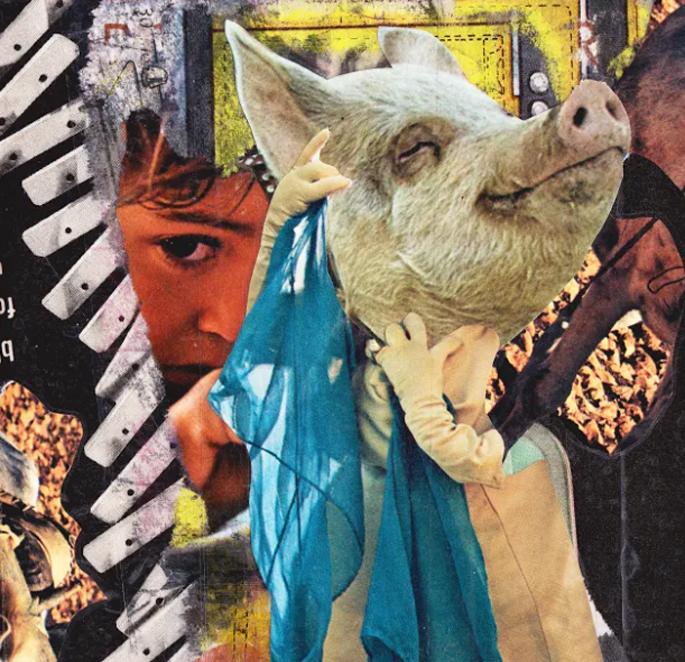
Do you feel like something would change if you didn’t have the isolation of living in Windham? You seem like kind of a hermit to me.
I will say that I really like talking to people, but my natural inclination is sort of not to. Working at Strange Maine definitely keeps me social. I was a fairly isolated kid and didn’t really have any real friends until high school, so being a bit isolated is a normal state for me. I’m very glad to live out in the sticks so that I have the space to decide whether I want to talk to or see anyone or not. I’m also so glad to be involved with the store and to have made so many great friend through music and art. My creative impulses, such as they are, were definitely born of being a weird isolated kid with no one else around that I related to.
What prompted you to start doing the DOES Series of shows?
Well, I did shows at Strange Maine for 13 years and once that was abruptly stopped I had to do something. The last string of Strange Maine shows were relatively well attended, I was feeling really good about booking, so I knew I wanted to continue somehow. I was really influenced by Andrew Chadwick’s “Action Research” series in Gainesville, Florida. He’s never been tied to one venue, the series has always moved from venue to venue, and I liked the thought of that. So, I basically decided to see if I could emulate that. The Apohadion reopening has been awfully helpful for that. That place is amazing and I’m so thankful to Pat and the gang for letting me book there.
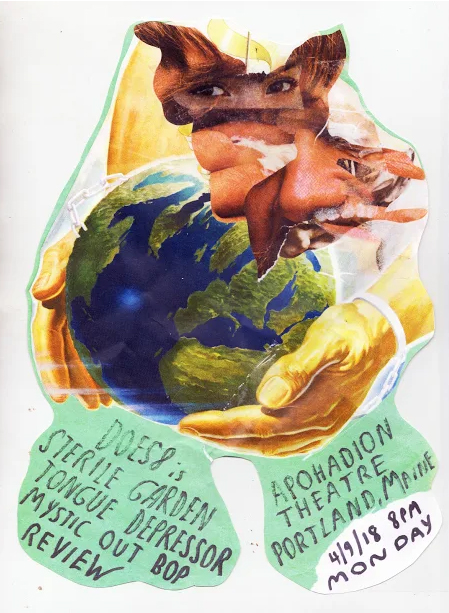
Let’s talk about 3D Jet Scooter, a trio you have with Frank Turek and Janane Tripp. Janane used to be in a band called Prisma that put out a record on Time-Lag Records, was in Visitations, and is in the Veasies. You seem to take turns determining who steers the direction or disrupts things, like Janane was doing last time you played.
3D Jet Scooter is me and two of my favorite people on the planet. Janane Tripp, known for her work in Visitations and Prisma, as well as her solo work, and Frank Turek who’s been making music and art in a myriad of genres and permutations around Portland since the late 80’s, I think. The range of what he’s done is amazing. I always tell people we’re a “spacey improv band”, but that’s pretty simplistic. It’s definitely improv, as the most we’ve ever decided beforehand is something like “let’s start quiet” or what have you. I really like the band, there’s something about the combination of playful personalities that works more often than it doesn’t. Sometimes it crashes, but usually it doesn’t.
